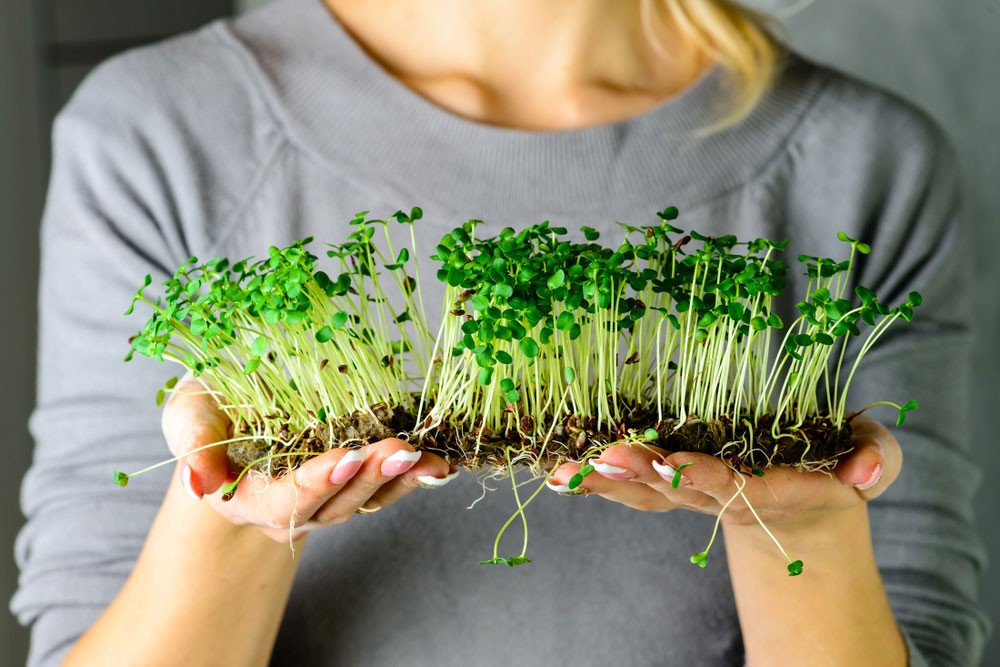Microgreens are young, edible vegetable greens, harvested at the cotyledon growth stage – the primary stage of the vegetable’s growth when the first set of true leaves sprout. This stage comes after germination, but before the development of roof and leaf structures, so these baby plants fall somewhere between a sprout and a baby green.
Due to their high content of antioxidants, microgreens are considered a functional food – a food that promotes health or prevents disease. Most commonly consumed by people focused on a healthy diet, they are also used to add flavor and a decorative touch to various dishes.
Whereas sprouts are seeds that have been soaked in water and harvested within 2-7 days, microgreens are grown in soil like their larger vegetable counterparts and are harvested after 1-3 weeks of growing time. Due to this growth medium, microgreens have a lower risk than sprouts of carrying water-borne bacteria like E.coli and pack more nutrition than sprouts as they absorb minerals from the soil.
The most popular microgreens are arugula, basil, beetroot, broccoli, cabbage, cauliflower, kale, and radish. All microgreens can be bought whole (still in soil), so they stay alive until you cut and consume them.
Let’s explore the health benefits of microgreens:
Microgreens are packed with nutrients:
According to a study in the Journal of Agricultural and Food Chemistry, while levels vary per species, microgreens can contain up to 40 times higher levels of vitamins, minerals, and phytonutrients – chemical compounds produced by plants – than more mature leaves. They are also rich in enzymes, making them easily digestible.
For example, according to the USDA National Nutrient Database, red cabbage microgreens contain 69 times more vitamin K, 40 times more vitamin E, and six times more vitamin C than the leaves of a mature red cabbage.
Combined, these vitamins play a significant role in our health:
- Vitamin E: An antioxidant that can help to prevent cancer, heart disease, cataracts, and Alzheimer’s disease.
- Vitamin C: Plays a role in the immune system, nervous system, and brain function related to learning and memory.
- Vitamin K: Vital for blood clotting, bone metabolism, and regulating blood calcium levels.
Prevent and manage diabetes:
Several microgreens, including red cabbage, red mustard, and mizuna, contain higher levels of cinnamic acid than their mature counterparts. This organic compound occurs naturally in plants is reported to improve glucose tolerance and stimulate insulin secretion. Exactly how this anti-diabetic activity of cinnamic acid works is still being studied.
Reduce the risk of heart disease:
Cardiovascular diseases are the leading cause of death globally. By modifying your diet – adding more plants to it and specifically microgreens – you can reduce your chance of becoming a statistic. In fact, microgreens help lower blood pressure due to their high levels of fiber and vitamin K. Considering that high blood pressure is a major risk factor for heart disease, including microgreens in your diet is highly recommended.
Prevent digestive diseases:
The high prebiotic fiber content of microgreens helps nourish the good probiotic organisms in your gut – maintaining a healthy gut is key to the prevention of digestive and other diseases.
Improve eyesight:
Squinting at your screen while reading this? Increase your leafy green intake by eating more microgreens. According to research by The Frontiers in Plant Science, the phytochemical lutein present in microgreens help your eyes absorb excess light intensity which generally leads to headaches and migraines.
Different colored microgreens provide different micronutrients, so eating a wide variety of microgreens will offer the most benefits.

Ready to kick off a healthier eating lifestyle? Start by growing microgreens at home. The process is easy, and microgreens can even thrive indoors if sunlight is available.
How to grow microgreens at home?
- Scatter seeds over 3 cm of potting soil in a planter dish or tray and cover with another thin layer of soil.
- Mist the soil with (clean) water and place near a source of sunlight or a grow light.
- Continue to mist the seeds daily to keep the soil moist.
The microgreens will be ready to harvest in 2-3 weeks. Cut the greens above the soil line and rinse well before using.
Add more microgreens to your daily diet – these concentrated sources of vitamins and minerals can boost your health, as well as add color, flavor, and visually pleasing touch to your sandwich, salad, smoothie, soup, or other dishes.

